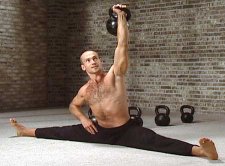Isometric Stretching
The Secret to Safe Instant Flexibility
By Paul "Batman" O'Brien
B.A., N.C.E.H.S., Dip. Acu., Cert Clin. IMed., Dip. Adv. OBB, Dip. CHM, Pn1, PN-SSR, PN-NCA, M.AFPA., M.C.Th.A.
Isometric Stretching is by far the most effective and safe method for increasing the range of motion of your joints. Before I explain how isometrics can be used for stretching and why it is so effective, allow me first to explain the difference between standard stretching and isometric stretching.
One involves stretching; the other doesn’t – at least not in the usual sense. Stretching in the traditional manner most of us grew up with and some poor unfortunate people still use is generally static in nature. By this I mean you place a muscle in an elongated position, past it’s usual comfort zone and slowly stretch or pull the fibres apart and then stay there. It usually hurts just a little. This lack of movement means it’s static – you just hold a position for say 30 seconds. Then do something else.
The fibres of your muscles are slowly pulled apart and weakened increasing your flexibility and range of motion. This can often lead to weak unstable joints that are prone to injury, especially around the knees and lower back. Without the tight strength of your supporting muscles, tendons and ligaments irt is all to easy to pop out a joint or strain it when in a weak position.
That isn’t what Isometric Stretching is about. Isometric Stretching is based on becoming stronger in those weak positions, having firm solid and tight tendons and ligaments capable of contracting against great force but still being flexible. How is this possible – how can isometrics stretching allow you to stay tight and strong, yet supple?
What if I told you your muscles are already long enough for a greater than full range of motion? What if I told you that you are actually flexible enough to do full side splits – right now? Would you believe me?

Pavel Tsatsouline in perfect side splits
Well it’s the truth and it’s the very basis of isometric stretching and its effectiveness.
Try this simple side splits test – I bet you’ll pass. Get out of the chair you’re sitting in, it’s okay, just go do it right now. Great, now place your right foot on the cahir keeping your leg straight. You should have you left leg straight, foot flat on the ground, creating a 90 degree angle. Got it? Cool. Now, do it with the other leg. You can sit back down now.
Most people, except for those very de-conditioned and those with anatomical injuries should be able to do that with ease. So why did I make you do that and what has it to with isometric stretching.
Simple. Placing your leg at a ninety degree angle proves you can do the splits. But, “wait”, you say “I might be able to do it one leg at each time, but there is no way, I can pull it off with both legs together to do a 180 degree splits.” It’s my pleasure then to tell you an interesting fact – there is nothing – and I mean nothing that connects one leg to the other. Take a look, both legs slot independently into the hip, no muscle runs across or connects them. Nothing. So why can’t you do the splits?
The blame lies in one of the bodies self protection mechanisms, primarily the Golgi Tendon Organ or GTO for short. The GTO measures tension in each muscle, how tightly it is contracted. It also creates this contraction in response to stimulus. Essentially as you attempt to do a side split, your body, thanks to the GTO contracts your muscles, because it’s afraid of injuring itself. Basically your body doesn’t trust itself and tenses you up shortening your muscles and preventing you from doing the splits.
Of course there is a way around this without stretching, elongating or weakening the muscle. And that is Isometric stretching, or what is often times called PNF, short for Proprioceptive Neuromuscular Facilitation. This is a method of controlled isometric contractions (if you want to know more about isometric contractions read this article) that overloads the muscles tension caused by the GTO, allowing you to achieve complete range of motion.
For instance in a side spilt one would try to squeeze the muscles of the legs together (using a muscle call the adductor) while tensing all the muscles of the leg. This contraction can be held from 7-30 seconds. At which point you can relax and deepen the stretch as a results of the body’s natural relaxation response.
This method teaches you to control your bodies muscular tension and allow it to achieve its full potential – not risk injury through weakening your bodies connective tissue.
If you’d like to learn more about PNF and isometric stretching I highly recommend Pavel Tsatsouline’s Relax into Stretch - Instant Flexibility Through Mastering Muscle Tension I’d also recommend his accompanying video/DVD here - Relax into Stretch Video/DVD Finally for the more advanced and adventurous you may wish to check out Super Joints- Russian longevity secrets for Pain-Free Movement, Maximum Mobility and Flexible Strength And don't forget to check out the Super Joints video/DVD
Isometric Stretching can Return You to Your Full Range of Motion - Learn How to Stay Strong Here










New! Comments
Have your say about what you just read! Leave me a comment in the box below.